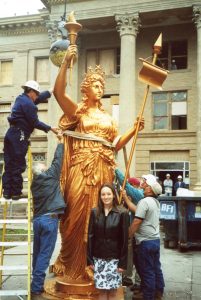The Bee County Courthouse, designed by William C. Stephenson and Fritz Heldenfels, was completed in 1912 for $72,050 and was expanded in 1950.
Bee County’s first court session was, in a word, primitive. The courthouse was fashioned of pickets, a clapboard roof, and a dirt floor, with a dry goods box serving as a bench. There were too few men to constitute a jury, so court was adjourned.
The current courthouse is the exact opposite. The Beaux Arts brick structure boasts clocks, classic porticoes, and a special Lady Justice, known as “Enlightened Justice,” atop the clock dome (see related story below).
Bee County was carved from parts of Goliad, Karnes, Live Oak, Refugio, and San Patricio counties in 1857. The official county organization took place a year later beneath an oak tree on Medio Creek, when residents selected a site 7 miles east as the county seat of Beeville. However, about 10 months later, the county accepted a land donation, and voters moved the seat to the banks of the Poesta. They named this permanent seat Maryville but soon changed it to Beeville on the Poesta.
Bee County was named after Colonel Bernard E. Bee, who served as secretary of the war during the days of the Texas Republic.
In 1954, the first U.S. Navy all-jet base opened in Beeville.
A variety of historical markers offer snapshots of history, including the old Praeger Building. San Antonio businessman Albert Praeger moved to Beeville in the 1890s to open a hardware store and tin shop. He built this Romanesque Revival structure in 1906 to house his business, which included buggies and wagons as well as barbed wire and tools. In 1925, the second floor storage space was converted into apartments. Since the turn of the century, this building has been a landmark on the courthouse square and now serves as the Bee County Library.
Geographically, Bee County is located in three biological zones. On the south and east is the coastal plain, to the north and west is the beginning of the Chihuahuan Desert, and to the east is the beginning of the Oak Savannah.
Bee County and Beeville lie in the center of South Texas. One hour from Corpus Christi, one and a half hours from San Antonio, three hours from Houston, and one hour from the coast, Bee County is the perfect rural location with near access to city necessities.
The area is a mecca for dove and quail seekers, and each year hunters come to their leases or ranches to enjoy the bountiful game.
The Beeville Country Club attracts visitors and homefolks alike with its famous food, golf course, reasonable prices, tennis courts, large pool for kids, and a beautiful clubhouse.
The Beeville Art Museum features rotating exhibits from renowned artists, collections from other museums and galleries, and private collections from across the state.
The county is also home to nine parks including Veterans Memorial Park, Koehler Park, Klipstein Park, Flournoy Park, Poesta Park, Trevino Park, Carlos Reyes Park, Moore Park, and the Martin Luther King Park/City Pool.
A Special Restoration
Local Beeville architects William C. Stephenson and Fritz Heldenfels designed the Bee County Courthouse. Stephenson also sculpted Lady Justice, who stands atop the clock dome. Unlike most representations of Lady Justice, this lady reigns from her perch not with a blindfold, but with her eyes open. Stephenson called his Lady Justice “Enlightened Justice,” or a representation of what justice should be. He thought the lady should have both eyes open to see who might be trying to tip the scales of justice one way or another. She has the mandate of the law (scroll of records) hanging on a staff in her left hand and the torch of knowledge in her right.
In the late 1990s, local elementary student Lauron Fischer noticed that the arm that Enlightened Justice was using to hold the torch appeared to be dislocated and tilted toward the ground. When Lauron joined the Sew ’N Show 4-H Club and learned that 4-H encouraged community service projects, she proposed that her club adopt the statue. The youngsters presented their restoration fundraising project to the Commissioners Court on Feb. 8, 1999. The court happily approved, and the club organized a car wash; from there, efforts to restore the statue grew. The full story is available at https://bit.ly/enlightened-justice.
In 2001, the statue was removed and taken to the Dallas Museum of Art for renovation. After the renovation, she was returned to Beeville and was temporarily stored/displayed in the lobby of a bank across the street from the courthouse, shared Paul Gerdes, Stephenson’s grandson. On March 2, 2005, a celebration of the reinstallation of Enlightened Justice was attended by many hundreds if not thousands of visitors and onlookers, Gerdes recalled.
“We all watched with great enthusiasm as she was transported from the bank lobby on a trailer and then lifted up with a huge crane and set in place as workers secured her to the top of the dome.” – Information provided by the Bee County Historical Commission, the Beeville Bee-Picayune, and Paul Gerdes.
For additional history, go to https://bit.ly/bee-courthouse.
















